I evaluated nine large and small packs that let adults and kids go with the flow. (Some even travel seamlessly from trails to town.)
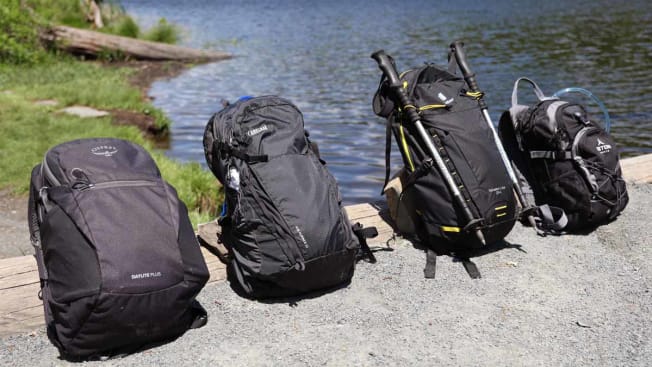
By Michael Frank
Whether hiking on nature trails or around a city, spending even an hour with a 1-liter water bottle in the side pocket of a backpack can make your back ache. It puts stress on your left or right shoulder and has you unconsciously using all the muscles on that side of your body differently from on the other side—from your hips up and across your back—as you try to compensate for the lopsided load.
By contrast, a hydration backpack is outfitted with a water reservoir, or bag, that sits directly against your spine, allowing your core and back muscles to remain balanced. And these water bags are designed so that you can (mostly) carry more liquid than you would in a traditional bottle and remain adequately hydrated.
For all its utility, a hydration pack can also be a lot like Grandparents’ Day, in that it’s a modern invention designed to sell you something you might not actually need. If all you want is to be able to walk around a city or on local paths for a few hours, any backpack that’s already comfortable might do the job if you slide a reservoir into the laptop sleeve and create a way to hold up the water bag so that it drains from top to bottom and sits flush against your spine. You may be able to convert even a pack without a laptop sleeve into a hydration pack by adding a reservoir with a pretty simple “hack” (see the Fjällräven Kånken, below).
Note: Not all hydration packs come with reservoirs (we indicate which do and which do not in our evaluations). A pack that doesn’t come with a reservoir can actually be preferable—even though it adds to the cost—because some of the reservoirs included with packs aren’t great. For packs that include a reservoir, note any comments on its performance. If a pack I evaluated did not come with a reservoir, I used the pack with one of the two reservoirs I also evaluated. (You can see my reservoir evaluations at the bottom of this article.)
Large Day Packs
For longer day hikes and carrying more gear.
Editor’s Pick: Deuter Speed Lite 24L
A supremely comfortable bag for serious day hikers or anyone who wants a pack that fits well and feels really secure.

Photos: Michael Frank and Mark Miller
Price: $115
Dimensions: 24 liters; 22x11x7 inches; 1 pound, 11 ounces
Where to buy: Amazon, Backcountry
Comes with reservoir: No
External stowage: Yes
Versatile for different body types: Yes
Waist strap: Yes
The Deuter’s brilliant fit system really conforms to your hips and shoulders, and while it fits close to your spine, its mesh back panel allows a decent amount of breathability. The smartly organized exterior has stretchy mesh side pockets large enough to carry even more water or a point-and-shoot camera; the hip belt has its own small, zippered pockets (perfect for an energy bar or a flask of sunblock); and a cavernous center exterior pocket is just large enough for stuffing a second layer of clothing, like a vest or long sleeve shirt. Two strands of daisy-chain loops allow you to attach collapsible walking sticks, a camera tripod, or, for serious mountaineering types, even an ice ax.
Inside, there’s a discrete zippered top pocket, which is fine for swallowing sunglasses, lip balm, and a few other small items. Otherwise, the Deuter’s interior is basically one giant empty space in which your gear swims around.
Also, while Deuter sells its own aftermarket reservoir for this pack, that’ll cost you an extra $30 or so, and unlike several packs here, the drinking tube only threads over the left shoulder, rather than through a central port that allows threading over either shoulder.
Best Comfort/Value Combo: CamelBak Rim Runner 22L
A solid pick for cost-conscious day hikers who value organization.

Photos: Michael Frank and Mark Miller
Price: $100
Dimensions: 22 liters; 19.7x10.6x9.4 inches; 1 pound, 10 ounces
Where to buy: Amazon, Backcountry, CamelBak
Comes with reservoir: Yes
External stowage: Yes
Versatile for different body types: Yes
Waist strap: Yes
This CamelBak has dual elasticized mesh side pockets and a larger rear pocket that’s large enough to fit a long sleeve shirt (a bulkier sweater had to go inside the pack). CamelBak, which arguably invented the hydration pack, also thoughtfully designed this model with a large top pocket with a central divider and an interior lined with bright orange fabric, so it’s easier to locate what you put where. The top pocket let me keep my gear organized and handy, and was large enough to accommodate my multitool, lip balm, sunglasses, and even my paperback, leaving the main cargo hold free for bulkier clothing layers.
Although there are daisy chain loops for carrying trekking poles, they don’t run the length of the pack, nor does the pack come with a strap system for securing the pole handles. The Rim Runner comes with CamelBak’s Crux 2.5L reservoir, which works fine but was prone to jostling free of its sleeve and slumping on the bottom of the pack, leaving the water weight poorly distributed and the pack slightly less comfortable than the Deuter.
The Work-to-Play Pack: Osprey Daylite Plus 20L
A well-organized pack that morphs from urban laptop bag to hydration pack for shorter weekend jaunts.
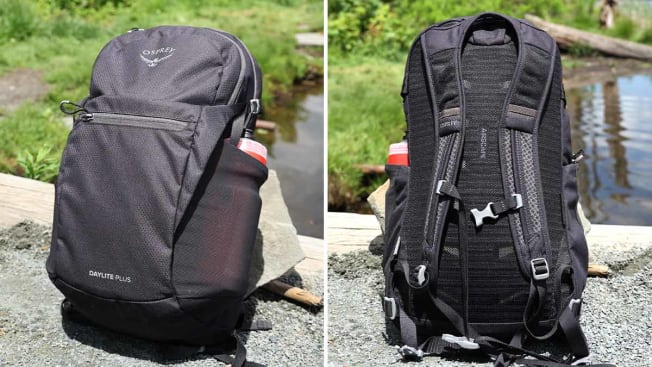
Photos: Michael Frank and Mark Miller
Price: $70
Dimensions: 20 liters; 18.9x11x9.5 inches; 1 pound, 5 ounces
Where to buy: Amazon , Osprey, REI
Comes with reservoir: No
External stowage: Yes
Versatile for different body types: Yes
Waist strap: Yes
The stealthier looks of the Daylite Plus don’t scream “hiker” when you’re rolling through the urban jungle, and you can remove the hip strap, too, for a sleeker carry. While the absence of a bulky hip belt confers a more urban vibe, when I crammed the Osprey with gear and a full two-liter reservoir, it grew a bit ponderous.
With lighter loads, this is a very comfy carry, especially for shorter jaunts under 2 hours. The longish back panel and adjustable sternum strap make this pack easy to fit long or short torsos, and two stretchy side pockets are large enough for carrying a water bottle or two if you want to ditch the reservoir during the week. A zippered third rear pocket (rather than the more common open-scoop design) adds a bit more security when commuting.
Like the CamelBak, the Daylite’s interior is lined with brighter fabric, and there are two main pockets. The outermost is divided into two sections; one has two small dividers at the top, ideal for glasses and my multitool as well as pens and business cards; the other is large enough to accommodate both a paperback and an iPad Mini. The main hold is roomy enough for a sweater or fleece, a bag lunch, a heavier rain jacket, and my foam seating pad, and has a reservoir sleeve that’s padded, so it doubles as a laptop slot (for up to 15-inch models). The HydraPak Shape-Shift 2L reservoir worked seamlessly with this pack.
Best Bang for Your Buck: Teton Sports Oasis 18L
A low-cost, versatile pack that has more going for it than against it.
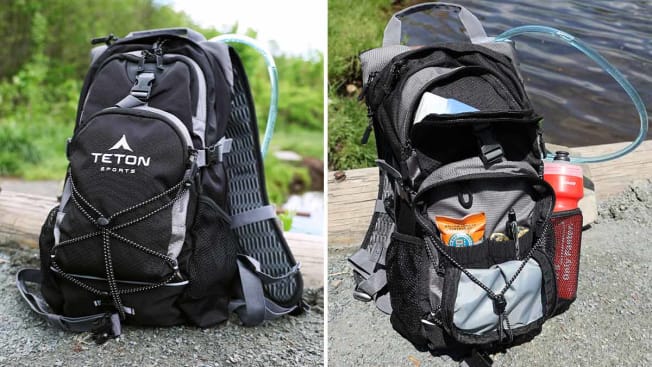
Photos: Michael Frank and Mark Miller
Price: $46
Dimensions: 18 liters; 18.5x10x7 inches; 2 pounds
Where to buy: Amazon, Tetonsports
Comes with reservoir: Yes
External stowage: Yes
Versatile for different body types: Yes
Waist strap: Yes
With both an 18-liter and 22-liter version of this pack, it fits more bodies comfortably. There’s no daisy chain system on this pack for carrying trekking poles, but the handy bungee cord on the exterior allowed me to quickly lash a rainproof jacket to the rear of the pack. (The Oasis even comes with a rain cover.) At the back of the pack there’s a lower pocket, which readily holds smaller items, such as a multitool and sunblock, while an upper pocket proved perfect for sunglasses, and two side mesh pockets are large enough to hold a can of soda each, or a snack or small camera. (While the side pockets are handy, they’re made of a less fine mesh than other bags, which means something sharp-edged, such as a multitool, pokes through, and they’re more prone to snagging on branches.) Although the Oasis is a bit on the “sporty” side to use for commuting, you can swap the reservoir out and slot in a laptop instead (it’ll fit a 13-inch MacBook Air without fuss). The Oasis also comes with its own reservoir, which has a bite valve that shuts tight when you’re not drinking from it, meaning you won’t find it unexpectedly leaking.
The Oasis comes with a waist strap, not a genuine hip belt like the Deuter, CamelBak, and REI models. So if you weigh it down, you’ll wind up with more tired shoulders. Its large main compartment is cavernous, but the zipper does not wrap entirely from side to side, so the cavity does not open completely. Finally, the reservoir’s screw-type closure makes it more difficult than the envelope-type to dry completely between uses.
The One to Skip: High Sierra Outside Commuter Pack
A pack with little more than price to recommend it.
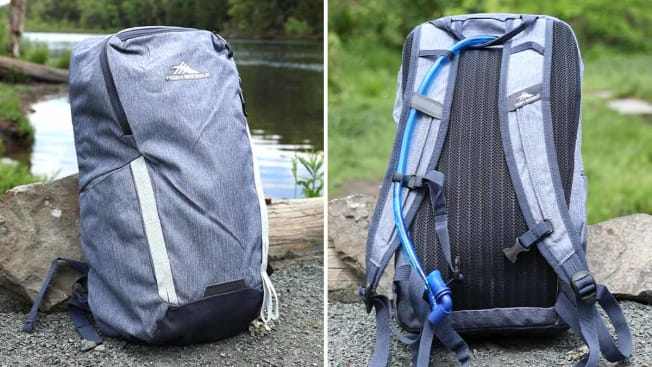
Photos: Michael Frank and Mark Miller
Price: $55
Dimensions: 16 liters; 19.5x13x7 inches; 15 ounces
Where to buy: Amazon, High Sierra, Walmart
Comes with reservoir: Yes
External stowage: Yes
Versatile for different body types: No
Waist strap: Yes
When you position this pack properly, so that the waist strap actually supports some of the weight, there’s no way to use the sternum strap: It won’t fall anywhere below the neck, even for a fairly short person like me. (Anyone taller than me wouldn’t be able to use the waist strap at all.) The pack can be made to function by stuffing the waist strap back into two pockets at the base of the pack and using the sternum strap, but it’s suboptimal.
Two external zip pockets work decently enough for stowing smaller items like sunglasses and an energy bar, but the single side pocket wasn’t designed to carry much of anything. A cell phone fits, but even a narrow water bottle or can of soda has to be muscled into and out of place. And don’t be fooled by the external webbing: It’s stitched down completely, so it’s purely decorative, rather than useful. Internally, the Outside Commuter Pack has zero organizational structure, nor does the pack unzip enough to allow you to easily see the interior.
While it’s sold with a reservoir, the closure mechanism that locks the flow is difficult to operate and sent water drizzling on my feet more than half the times I thought I’d shut it. You could nix the reservoir and fit a laptop inside instead, and there’s room aboard for a few layers of clothing and certainly a box lunch. If you wanted to use this pack for commuting, and only sometimes as your personal dromedary, it might be forced into reasonable service.
Smaller Day Packs
For city touring, shorter hikes, and lighter loads.
Style Meets Substance: Fjällräven Kånken Laptop 15”
An on-trend, comfortable, everyday commuter pack you can “hack” to convert into a hydration satchel for weekends.
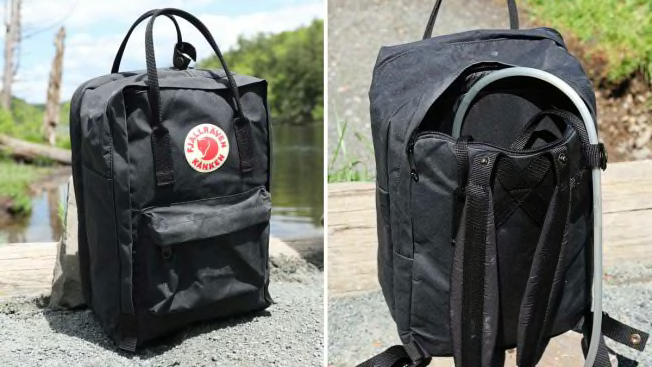
Photos: Michael Frank and Mark Miller
Price: $120
Dimensions: 18 liters; 15.75x11x6.3 inches; 1 pound
Where to buy: Fjällräven, Macy’s
Comes with reservoir: No
External stowage: Yes
Versatile for different body types: Yes
Waist strap: No
The Fjällräven Kånken is a stylish and sturdy little pack with a solid foam panel that rests against your spine, making it comfortable and also giving it structure so that it’s easy to pack. The standup grab handles (think luggage, not backpack) allowed me to use the pack as both a shopping bag and a briefcase when I was making my own take-away picnic during a business trip in Madrid.
Two side pockets are each just big enough to fit a can of soda, and the zippered back pocket is ideal for smaller items, such as a multitool, earbuds, a tube of sunblock, and pens. Loading the Kånken is easy because the entire pack unzips to reveal the contents. For one hike I rolled a sweater into the bottom, added my camera in a small carrying cube, rolled my windbreaker in around that, and, before my hike, grabbed a bagel sandwich and an apple from the deli and stuffed them into the top.
While it doesn’t have a dedicated sleeve or anchor for a reservoir, I converted the Kånken into a dromedary by attaching the HydraPak reservoir to one of the upright handles with a small drugstore sprung carabiner and letting it dangle through the partly open top like a fish on a hook. Was it perfect? Not exactly. But with the drinking tube snaking back out, I was able to use this pack just as I would a dedicated one for hiking. The lack of a waist strap makes this pack less comfy for all-day use. But for day hiking it was more than fine for a few hours of humping along a dirt path.
Comfort and Features in a Small Package: REI Co-op Link 15L Hydration Pack
Ample carrying capacity for casual cyclists and day hikers.
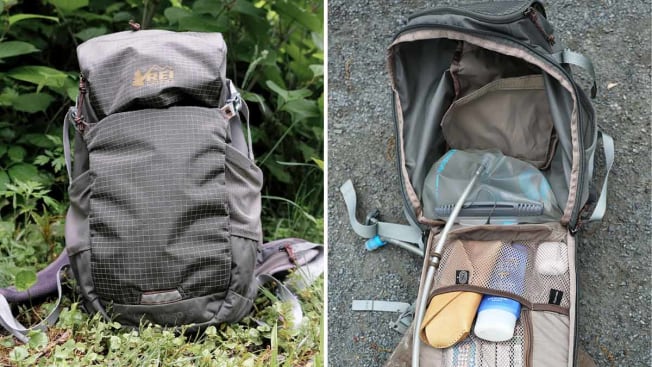
Photos: Michael Frank and Mark Miller
Price: $100
Dimensions: 15 liters; 17x10x7 inches; 1 pound, 6 ounces
Where to buy: REI
Comes with reservoir: Yes
External stowage: Yes
Versatile for different body types: Yes
Waist strap: Yes
In addition to small zippered mesh pockets in the waist strap that are handy for carrying a snack, the REI Link has dual mesh side pockets and a central stuff slot that’s just big enough to fit a windbreaker or lightweight layer. The main hold has three mesh pockets in varying sizes, all sewn against the panel that sits closest to your spine. The top one was dandy for holding my multitool, earbuds, lip balm, and the like, while the smaller of the two lower slots held my sunglasses and the larger one anchored down my paperback book and a rolled magazine. The rest of the cavity easily gulped my sweater and a windbreaker.
The rear of the pack is made of a tougher nylon than some other packs we evaluated, and it’s designed to be water-repellant, too. The Link also comes with a legit waist belt, not just a strap, which helped make this one of the most comfortable small packs I tested. It was trickier to get the waist and shoulder straps situated perfectly, but once I did the pack sat very securely. Its unique reservoir design adds to the comfort: The square shape of the HydraPak Lumbar 2L SL reservoir it comes with lets it sit lower in the pack, right at the base of the spine. Like the HydraPak Shape-Shift 2L (below), the bite valve requires a little more effort than the CamelBak reservoir, but is easier to fill, clean, and dry.
Note: The sternum strap can wriggle free of the track that allows it to be adjusted vertically, rendering the pack sternum-strap-less. With patience, you can reattach the strap, but it’s not easy to do, and unfortunately, this happened repeatedly. An irritating design issue, but not a deal-breaker on a pack that has so much to offer.
Day Packs for Kids
Small, light packs for junior trekkers.
For Pint-Size Hikers: CamelBak Mini M.U.L.E. 1.5L
A good—but not perfect—pared-down pack for young people.
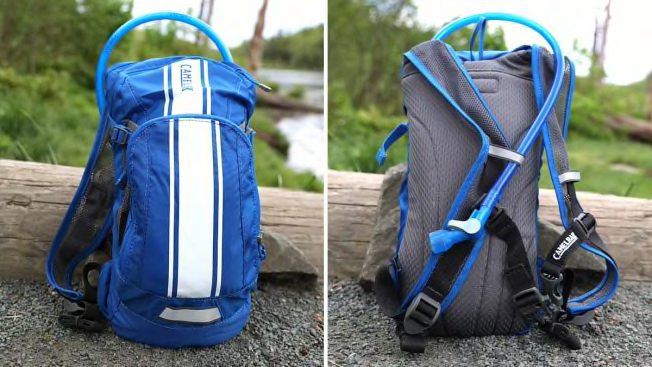
Photos: Michael Frank and Mark Miller
Price: $55
Dimensions: 1.5 liters; 14x7.5x7.7 inches; 7.4 ounces
Where to buy: Amazon, CamelBak, REI
Comes with reservoir: Yes
External stowage: Yes
Versatile for different body types: No
Waist strap: No
What we like: Two quick-release straps allow you to attach a rain slicker or another light outer garment. The rear pocket has decent internal organization, with a few slots for your kid to tote their own energy bar and snacks, and perhaps a Swiss Army knife or multitool.
What we don’t like: As with the larger CamelBak we tested, the smaller reservoir that comes with the Mini M.U.L.E. is harder to dry out after use. And the preteen member of our evaluation team found that after taking the pack off (as when resting) and putting it back on, the water bag would sometimes get wedged in such a way that the drinking tube would kink. This issue was easy for an adult to remedy but could prove to be a puzzle for a child.
For Older Tweens and Teens: Thule UpTake
A comfortable pack with a little more heft and added room and versatility.
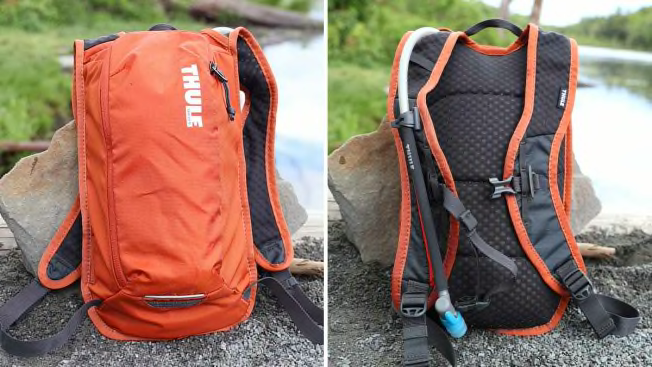
Photos: Michael Frank and Mark Miller
Price: $70
Dimensions: 6 liters; 7.1x5.1x12.6 inches; 12 ounces
Where to buy: Amazon, Moosejaw, Dick’s Sporting Goods
Comes with reservoir: Yes
External stowage: Yes
Versatile for different body types: Yes
Waist strap: No
Our 11-year-old evaluator found that this pack fit better and was more comfortable than the CamelBak Mini. It’s roomier, too, with enough space aboard to swallow a kid’s sweatshirt or fleece with room left for an energy bar, tool, and earbuds. The Thule’s drinking tube is magnetized and automatically reattaches itself to the shoulder strap of the pack, rather than flopping around while walking, a feature our 11-year-old evaluator thought was especially cool.
The 1.75-liter reservoir can be opened entirely for ease of drying, but the complexity of filling it, closing it properly, and emptying it was a little tricky for our youngest evaluator to master.
The Process: How I Evaluated These Packs
A good hydration pack has to be a good backpack first: It has to be comfortable, have a logical organizational and pocket structure, and feel sturdy enough to hold up to the abuse of a trail hike, as well as possibly crossing over to use in daily life, for commuting to work or for travel.
It seems silly that this oftentimes fairly costly purchase should be useful only for a daytime walk in the woods. That’s why we evaluated an array of packs with versatility and fit in mind. As with a pair of shoes, a backpack may fit your body differently than mine, so I also recruited my taller, longer-torsoed friend, Mark, to test fit on his body as well. For a kid’s perspective, his 11-year-old daughter helped us evaluate two child-friendly hydration packs on a few hikes.
The three of us tested the packs over the course of more than a month of day hikes, city walks, and domestic and foreign travel. We used them in wind, sun, and rain, and we stuffed them with spare clothing, supplies, and other sundries. I always carried the following.
- A multitool
- Sweater or vest; rainshell
- Reading glasses and/or sunglasses
- A paperback book
- Snacks
- Lip balm
- Earbuds
- Mask
- Phone
- Chunk of foam padding as a makeshift seat when I stopped for a snack or lunch. (Note: This fit in the larger packs but not in the smallest ones.)
Reservoirs
A reservoir is basically a bag designed to carry water. It has a flexible hose that connects to its bottom and snakes out of the backpack, typically through a slot on either the left or right shoulder strap, then loops around so that the end is easy to draw up to your mouth for a quick sip. The tube has what’s called a “bite valve” at the end of it, which you pinch open with your teeth as you drink. Many also have a closure at the end of the bite valve, to manually lock out the flow of liquid. As noted above, not all hydration packs come with reservoirs, so I evaluated the ones below for ease of drinking, ease of filling, and cleaning, to help you choose the one that best suits your needs.
HydraPak Shape-Shift 2L
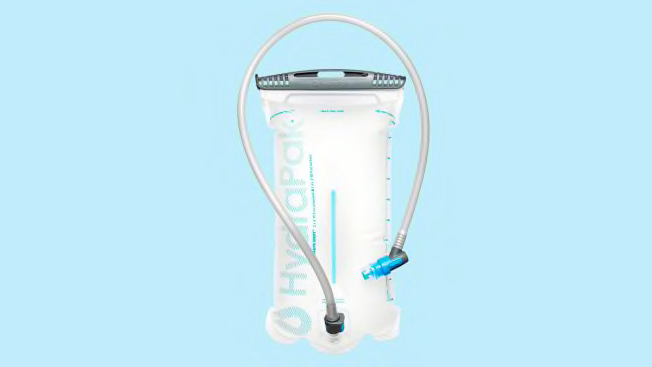
Photo: HydraPak
Price: $38
Where to buy: Amazon, HydraPak, Target
Pros: The BPA & PVC-free Shape-Shift 2L is made like a big envelope. The top seals with a sliding bar; it’s sort of like a clamp that holds together two lips that interlock (think of this like a zippered plastic bag with a vise that prevents it from unzipping). And because the top opens wide, it’s easier to turn the whole thing inside out when not in use, so you can hang it on a clothesline or over a dishwasher drying rack to prevent any funk from forming; the enemy of a safe reservoir is remaining moisture once you’ve washed it out. The Shape-Shift 2L was just easier for me to invert and dry.
This bag is also freezable, which you may want to do if you’re headed out in really hot weather and want the added cooling effect on your back. (Pro tip: Freeze one-third of the capacity the night before a hike, and then top up to full the next morning. That will give you liquid water from the outset that stays cold through your day.) And there’s a quick-connecting hose that’s easier to remove, and therefore, to clean and let dry, than designs without this feature.
Cons: The bite valve is a little harder, literally, than the CamelBak’s, so it’s not quite as tooth-friendly. It’s not a deal-breaker, but as a matter of preference, the CamelBak’s is just kinder. The closing system that clamps the sides of the reservoir together also takes some breaking in, so it can be a challenge, at first, to get it to slide. I found that just wiping the top edge with a little canola oil fixed the issue, and after a few uses the track operated more smoothly.
CamelBak Crux 2L

Photo: CamelBak
Price: $35
Where to buy: Amazon, CamelBak.com, REI.com
Pros: The CamelBak name was really built on an excellent, easy-to-use bite valve design that allows quick-flowing water with no internal structure that you might inadvertently chomp down on and crunch. CamelBak’s locking straw shut-off (think: the tap in your home) is also easier to operate than the HydraPak’s, simply because it’s bigger and you can rotate it more easily if you’re in the middle of trudging up really steep terrain. While I have some issues with the fill closure mechanism of this BPA/BPS/BPF-free reservoir, elaborated on below, it locks very securely, leaving little doubt when it’s actually shut.
Cons: You can turn the Crux 2L inside out, but the process makes for a battle, and getting all the inside guts to invert for ease of drying, as you can with the HydraPak, is just about impossible. CamelBak’s design also features a proprietary two-pronged hook for hanging within the company’s own packs, which means it’s not as easy to retrofit to a pack that doesn’t come with its own hydration sleeve. I tried to use the CamelBak with several such packs but eventually gave up and just went with the HydraPak. And you can’t not hang a reservoir because otherwise it becomes a lump in your backpack, making it difficult to draw water through the drinking straw.
How to Care for Your Reservoir
Never put any fluid into a reservoir other than water. It might be tasty in the moment, but it could encourage bacterial growth. And because it can be hard to clean a reservoir, you’re brewing a recipe for ickiness. To clean a reservoir, buy some denture cleaning tabs. There are “special” reservoir cleaners that can cost 10 times as much, but denture cleaners use the same ingredients: mostly sodium bicarbonate, citric acid, and sodium carbonate peroxide.
And, yes, even if you drink only water from your reservoir, you need to clean it after each use, because your mouth contains bacteria that washes back through the drinking tube. So after you’ve dissolved the denture cleaner in the water in the reservoir, make sure to siphon a healthy amount of that liquid through the tube. Then rinse thoroughly, invert the bag and do your best to open both ends of the drinking tube, removing the bite valve according to the instructions. Hang both the reservoir and the tube on a clothesline or in a dish drying rack.
Consumer Reports is an independent, nonprofit organization that works side by side with consumers to create a fairer, safer, and healthier world. CR does not endorse products or services, and does not accept advertising. Copyright © 2022, Consumer Reports, Inc.

